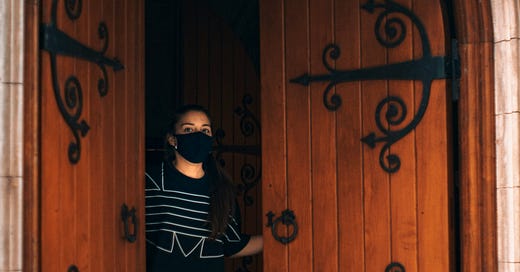I Knew This Would Be My Last Sunday in Congregational Worship
Personal Reflections on Responses to the COVID Pandemic in a Denominational Organization--Part One
I Knew This Would Be My Last Sunday in Congregational Worship
At least for a while.
On Friday, March 13, 2020 the US President declared a national emergency due to the spread of COVID throughout the world, and now significantly in the United States.
At first the closing of all large group gatherings was not prohibited, but it was discouraged. Later the combination of orders not to assemble and fright about the pandemic caused the vast majority of congregations to cease meeting—at least for a while.
On Sunday, March 15th I was scheduled to preach at one of the rural Baptist congregations outside Columbia, SC. As executive director of the association I was sympathetic to the pandemic crisis while also responsive to the request of congregations.
I connected with the lay leader of the congregation—which was without a pastor at this time—to see if they were going to meet.
“Yes,” was the immediate answer. “Not everyone will come, but we are not afraid of this thing. Some believe it is a conspiracy of some type. Farmers in our community say herd immunity could be a good thing to achieve, so it is all right if some people get sick.”
I wanted to ask if it was all right if they not only got sick but also died. But I suspected the answer could even be something like, “If that is what God wants, then it is OK!”
Perhaps my thoughts were too judgmental.
I went, preached for them, and it was the last Sunday I was live in a congregation for months.
It was also the last Sunday this congregation met for worship for a while. Enough people felt the seriousness of the situation that they stopped coming together for worship and other activities for a couple of months.
Early Fears
No one knew exactly what to do. This was not like other types of disasters such as hurricanes, floods, fires, tornados, etc. This was a silent killer.
At this point we were really not sure how high a percentage of people who contracted COVID would die.
Almost all congregations stopped meeting live. Schools closed. Places of work were shuttered. Restaurants closed. Stores closed. Many government offices were not open at first.
N95 masks became a precious commodity. Masks of various kinds could be secured, but their effectiveness was unknown.
Early Response Efforts
Immediately on Monday the most important means of communications beyond telephone calls, text messages, and email became Zoom videoconferences. The use of Zoom and other videoconference services became a geometrically booming business.
A Side Note: Often when a disaster happens, there is a relatively new technology that plays an important role. An example is in 1989 when Hurricane Hugo came through South Carolina, fax machines became the new way of communicating between disaster response organizations. We used it at the SC Baptist Convention in Columbia to communicate with the statewide disaster response command center to get authorization to move into a new location to provide relief work. Rather than driving an hour and standing in line for another hour, we sent a fax. We generally received permission within five minutes.
As soon as I could get the word out, we began having almost daily videoconferences among Columbia area congregations. Before long these backed off to weekly, and then every two weeks. These video conferences allowed us to network with the almost 100 congregations in our association.
I could read the panic on the faces and hear it in the voices of pastors.
We passed along information we received from official sources. Discredited rumors that abounded. Discovered the situations of our congregations and what they were trying to do or deciding not to do.
Shared great ideas that congregations could try. Found out what resources might be most helpful to them.
Made plans to discover and distribute these resources. Prayed for one another and otherwise supported one another.
The biggest issues were how and when would they worship, meet the spiritual, emotional, and physical needs of their congregations, and survive without the regular offerings other than those faithful congregants would provide.
Further, how could pastors and staff persons continue to minister to their congregation without exposing themselves and their families to COVID?
It did not take long for some answers to emerge.
Part Two will talk about Flattening the Curve.




